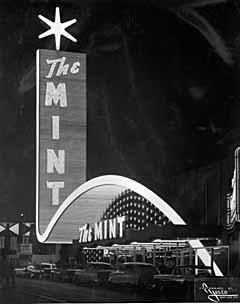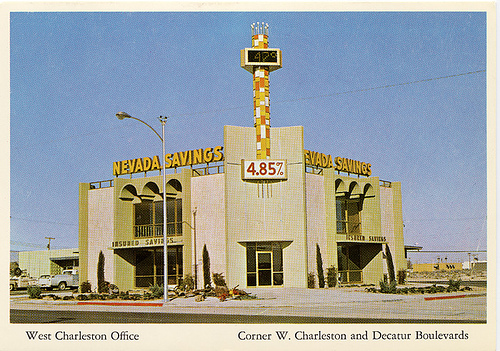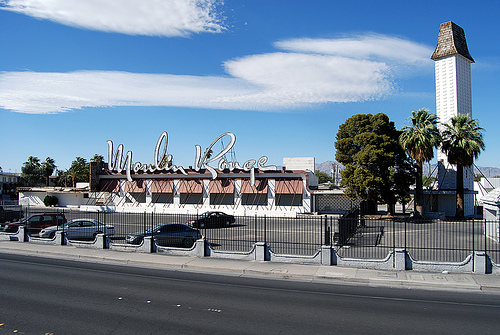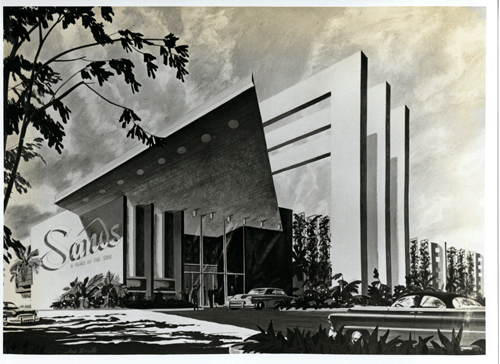Walter Zick - Mid-Century Modern Las Vegas Architect

The Mint Hotel designed by Walter Zick and Harris Sharp
He was one of the most prolific architects in Las Vegas. Walter Zick, along with his partner Harris Sharp, designed some of the coolest mid-century modern buildings in Southern Nevada. His best known design is probably also the most-beloved, the fabulous Mint Hotel. It's design fulfilled the optimistic potential that was pervasive across America in the late 1950s and the early 1960s. In that canyon of neon called Glitter Gulch, the Mint sat shoulder to shoulder with fanciful facades that depicted the Barbary Coast (The Golden Nugget), the Wild West (The original California Club) and San Francisco (The Golden Gate).
Wayne McAllister's design of the Fremont Hotel may have been the first mid-century modern casino on Fremont Street but Zick and Sharpe saw that design and raised the stakes. Working with YESCO's top designers, Kermit Wayne and Hermon Boergne, the facade of the Mint was one of the first to explore the three dimensional aspects of neon. It's eye-poping pink and white neon took your breath away.
If the Mint was all that Zick and Sharp had designed in Las Vegas that would be enough. But thanks to Friends of Classic Las Vegas commercial chair Mary Martinez and our favorite downtown neighborhood blogger, Jack LeVine, I have been given a disc of images and information on the life and works of Walter Zick. His family is trying to get a school named for him and though their initial request was turned down, we are thrilled to be joining with VeryVintageVegas to help spotlight Zick's accomplishments and keep the idea of a school named in his honor alive.
Walter Zick designed more than just casinos and hotels. I grew up in Charleston Heights which sports many of the schools and commercial buildings that he designed. I am familiar with Hyde Park Junior High School which was the first air-conditioned school in the nation. My brother was born at Southern Nevada Hospital in the mid-1960s when it sported a Zick and Sharp mid-century facade. I attended junior high school at Garside, which they designed. I attended high school at Ed. W. Clark High School which was designed by Zick and Sharp. They designed both Western High School and Valley High School, both cross-town rivals of Clark. We attended football games every Friday night at the Sam Boyd Silver Bowl, again designed by Zick and Sharp.
After I graduated in 1975, I attended UNLV and had a Shakespeare class in the Humanities Building that Zick designed. The Maude Frazier Building, the first building on the campus when it opened in 1958 was designed by them.
We did our banking at the corner of Charleston and Decatur at the Bank of Las Vegas and the First National Bank of Nevada both designed by Zick and Sharp. The Foley Federal Building which was built next to the 5th Street Grammar School where I attended kindergarten was also designed by them. The Clark County Courthouse near the Foley Federal Building is their design.
I remember the Nevada Savings and Loan Headquarters, the Nevada State Bank near then-popular Spanish Oaks, Western Airlines terminal, the Westgate Shopping Center, the YMCA addition.
In addition to the Mint, he designed the Bird Cage Casino which sat just west of the Mint and was ultimately annexed by the hotel and he and Sharp designed the famous "eyebrow" addition. They helped complete Wilbur Clark's Desert Inn, had a hand in the remodel of the El Rancho Vegas, designed the first integrated hotel and casino, the Moulin Rouge as well as the Union Plaza and many more.
He also designed residential homes for some of the biggest movers and shakers in Las Vegas including Benny Binion, the Cashman family, Marcus Daly (whose rec room included a below ground bomb shelter, a bowling alley and a movie theater), architect Bill Moore's house, Mayme Stocker's house on Bracken Avenue, Joseph Switzer's house and Ted Weins as well.
We'll hopefully have more on Walter Zick in the days and weeks ahead so keep an eye out here!

Destroyed for a Walgreens.

The Moulin Rouge (with signage by Betty Willis) before the fire of 2003.
Special thanks to RoadsidePictures for letting use this image.
Special thanks to the family of Walter Zick for letting us highlight his life.
Special thanks to Mary Martinez and Jack LeVine for the disc!
Las Vegas Neon Museum needs your help!

The wonderful Las Vegas Neon Museum needs your help!
Please help the Las Vegas Neon Museum save Vegas history...it only takes a click!
Please vote for the Neon Museum as your choice for Hampton Landmarks'
All-American Nevada Landmark.
If selected, Hampton will aid the Neon Museum in its creation of a permanent home, with a restored La Concha Motel lobby as its stunning visitor's center.
Help the Neon Museum-vote now! Tell your friends!
http://www.hamptonlandmarks.com/VoteLandMarkResults.aspx?state=28&statename=Nevada
Las Vegas Sands Hotel becoming a virtual reality

From our friend Charlotte Hsu at the Las Vegas Sun comes this interesting story about a website dedicated to everyone's favorite 1950s hotel, the Sands!:
It’s a project at the intersection of history and technology, meant to rekindle the magic of old Las Vegas.
In a drab room of cubicles at UNLV, Aniello De Santi, Marco Antognozzi and Marco Locatelli are resurrecting The Sands, the storied Strip resort imploded on a clear night 12 years ago, collapsing into a mountain of memories and dust.
In the lobby of the students’ virtual version of The Sands, everything mirrors the original — the color and shape of the lounge chairs (red, with curved bodies), the pattern on the carpet (like splashes of paint on canvas), the mural behind the old Sands bar (desert scene with a covered wagon and a Joshua tree). Even napkins on the counter are modeled from archetypes, with wavy edges and red-brown lettering proclaiming The Sands “a place in the sun.”
The details that the students from Politecnico di Torino, a well respected engineering and design school in Turin, Italy, are incorporating are exquisite, painstaking.
But the objective, as De Santi says, is not to craft a perfect replica. So in the lobby, by the blackjack tables, is an icon, an “S” floating in midair. Approach it and you are treated to a slide show, a series of black-and-white snapshots from the late 1950s and early 1960s showing crowds playing 21 at The Sands.
In the Copa Room, you will be able to listen to Copa Girl Virginia James as she chatters away about daily life as an entertainer in Vegas’ classic age. Identifying the correct performers in a trivia game will give you access to digitized videos of performances first recorded on 16 mm film. The flickering imagery is part of the charm.
The point of De Santi, Antognozzi and Locatelli’s interactive exhibit is to give us a new way to experience Las Vegas’ past.
In their virtual Sands, everything is a piece of history. You can stop and play virtual roulette on a virtual table whose virtual top is copied from photographs taken at The Sands.
In this environment, “people can see, touch and play with the material” from UNLV’s Special Collections, De Santi says.
“It’ll bring the collections to light in a whole new way, and also, it would maybe expose them to people who aren’t familiar with historical research,” says Su Kim Chung, a manuscripts librarian who has been helping the young artist-engineers locate items for the project.
Master’s degree students studying media and cinema engineering, De Santi, Antognozzi and Locatelli arrived in Las Vegas in early September to begin their thesis project, called “Re-living Las Vegas,” the cornerstone of a new, ongoing partnership between UNLV and the Politecnico.
Each student is living on a 3,000 euro (about $3,800) stipend from the home university to study abroad. They used their money to rent an apartment at Desert Inn and Swenson. Each also bought a bicycle — “the cheapest bikes at Wal-Mart,” Locatelli says.
But all three were stolen on campus so the students now take the bus to UNLV, where they have spent 13 hours every day of the week for the past month.
“They started from scratch. They had nothing,” says Dan Cook, coordinator of UNLV’s entertainment engineering and design program who is overseeing the project along with fellow entertainment engineering professor Joe Aldridge and Politecnico professors Andrea Bottino and Vittoria Lera. “This is really incredible, what they’ve been able to produce.”
The students are creating their interactive exhibit with the C4 Engine, computer programming tools typically used to develop video games. Games, Cook says, have failed to meet their potential as an educational tool, and De Santi, Antognozzi and Locatelli are helping to change that.
Cook says the public will be able to access “Re-living Las Vegas” within the next year.
The students chose to resurrect The Sands because in the ’50s and ’60s, it was “the place to be in Vegas,” De Santi says. “It has the biggest stars, the most luxurious hotel.”
Stars such as Frank Sinatra and Dean Martin, in all their magic, frequently graced the stage. Visitors played roulette on tables in the pool.
The hope is that a gaming corporation, museum or other institution will be interested in displaying the project and provide money for continued research. If that doesn’t happen, Cook said, UNLV will make the virtual Sands available through its Web site.
De Santi, Antognozzi and Locatelli will leave UNLV at the end of this month. But a new group is expected to arrive from Italy in February.
Cook says UNLV students, too, will work on the project in the future. Those studying history, for example, could sift through archives to find the best materials.
Today, the virtual Sands is empty. De Santi, Antognozzi and Locatelli have not yet created the people — avatars in the language of the digital world — who will roam the casino floors.
But as “Re-living Las Vegas” advances, the old Las Vegas landmark will come to life. Background audio will fill the virtual Sands with the sounds of Las Vegas’ golden age. Future students, perhaps, will recreate the showgirls, with their headdresses, metallic heels and painted lips, who hung off the sides of open-air trams shuttling patrons around the resort.
In creating their interactive exhibit, De Santi, Antognozzi and Locatelli examined hundreds of pictures and documents and other materials, most from a collection of Sands publicity and advertising files that the hotel donated to UNLV in December 1980.
They listened to hours of oral histories, combed through old black-and-white films and watched movies set in the Sands including “Pepe” and “Meet Me in Las Vegas.” They know that the ceiling of the Copa Room was green because a stranger they met while researching in the library mailed them an old photograph depicting it.
At the heart of what they’re doing is telling a story, bringing the old Sands back to life, conjuring a once-mighty hotel from the dust and memories, from what remnants remain.
Special thanks to RoadsidePictures for letting us use this photo.
New Year's Eve Celebrations
I know it's a tad early to be thinking about it but for those who plan ahead, here is the info regarding Firework Displays and more on New Year's Eve this year:
America’s Party to Bring Fireworks Closer to the Las Vegas Strip
Pyrotechnic display to highlight citywide celebration
Las Vegas Events and the Las Vegas Convention and Visitors Authority (LVCVA) announced today that ground locations will be utilized as firing points for the New Year’s Eve fireworks extravaganza known as America’s Party.
The fireworks show is designed to bring the pyrotechnics closer to the visitors on the Las Vegas Strip, while introducing new design elements.
The tentative firing locations include (from the south, heading north):
Mandalay Bay – Convention Center Lot (corner of Russell and Las Vegas Blvd.)
Luxor – Parking Lot (across Las Vegas Blvd. on the corner of Mandalay Bay Road)
MGM Grand – Parking Garage
Paris – Parking Garage
Caesars Palace – Parking Garage
Treasure Island (TI)/Mirage – Valet Parking Garage
Las Vegas Convention Center – Gold Parking Lot
Stratosphere – Parking Garage
Fremont Street Experience – Under the canopy
In previous years, when the show was fired off hotel rooftops, the fireworks could be seen throughout the valley. Due to the change in firing locations, the best viewing areas will now be ground level on the Las Vegas Strip. Local residents are also encouraged to take the firing locations into consideration for ideal viewing.
“America’s Party is a signature event for Las Vegas,” said Las Vegas Events President Pat Christenson. “Our goal each year is to develop a show that is worthy of this great city, and this year we will bring it closer to the revelers on the Las Vegas Strip.”
Fireworks by Grucci has been contracted to coordinate the pyrotechnic display. Fireworks by Grucci of New York, innovators in state-of-the-art displays, is world renowned for its pyrotechnic creations. The group recently coordinated the fireworks display at the Beijing Olympic Games and has executed numerous presidential inaugurations and citywide celebrations. Locally, Fireworks by Grucci has produced many of Las Vegas’ largest special events and grand openings, including the official Las Vegas Centennial celebration.
"This will be the fifth time that we have been commissioned by Las Vegas Events to coordinate America’s Party,” said Donna Grucci Butler, president of Fireworks by Grucci. “This show is billed as America's largest New Year’s Eve Party, and it will be coordinated and designed in true Las Vegas style.”
Thematic elements and the musical soundtrack are in the final stages of development and will be officially announced at a press conference on Tuesday, Dec. 16 at the Fashion Show Mall, located on the Las Vegas Strip.
America’s Party is the official moniker coined by the LVCVA and Las Vegas Events to signify the annual citywide celebration on Dec. 31. This year’s festivities include both the themed fireworks extravaganza on the Las Vegas Strip, as well as the live concerts and fireworks under the canopy at the Fremont Street Experience. Themed as “TributePalooza,” the world’s best tribute bands will be performing fourteen hours of live music from 6 p.m. until 1 a.m. (PT) on both the 1st Street and 3rd Street stages on Fremont Street Experience. Tribute bands will be performing as Billy Joel, Eagles, David Bowie, KISS, Rolling Stones, U2, Queen and Aerosmith.
2nd Annual Las Vegas Showgirl Art Competition Exhibition
The Second Annual Las Vegas Showgirl Art Competition Exhibition opened at the Nevada State Museum, Las Vegas on November 10. On display in the East Gallery are the artwork from this year's competition, as well as showgirl costumes and accoutrements.
The Las Vegas Showgirl Art Competition was established by former showgirl Lou Anne Chessik who performed on Las Vegas stages from 1979 – 1991 in such productions as Hallelujah Hollywood, Jubilee!, Lido de Paris, and Enter the Night. Chessik founded the competition in 2007 as a way to preserve and commemorate the world of the showgirl and the elaborate costume productions that were once common in Las Vegas and Reno showrooms.
"It's its own world and it's all going away," Chessik says. She doubts productions of similar scope and proportion will ever return. "It's so expensive to even create shows like that now."
The showgirl tradition dates back to the 1869 Paris premier of the Folies Bergère. Showman Florenz Ziegfeld brought showgirls to the American stage in the 1910s and '20s, while producer Donn Arden introduced them to Las Vegas when he opened Lido de Paris at the Stardust in 1958.
Featured in the Nevada State Museum, Las Vegas exhibition are designer Bob Mackey's Blue Cage costume from the finale of Bally's Jubilee!, as well as costumes and accessories from Hello, Hollywood, Hello, performed at the MGM Grand Reno in 1978-89.
Sponsors of the Las Vegas show include Karen Burns Productions; Technology Exclusive; Escobar & Associates; Cindy Doumani; Denny Weddle & Associates; the Houssels Family Trust; Carolyn Sparks; and the Cast & Crew Reunion.


